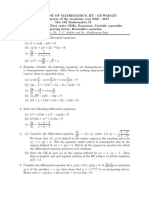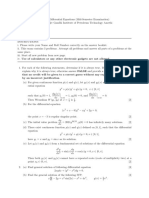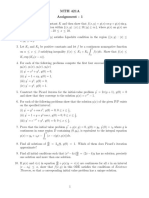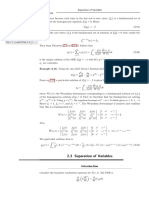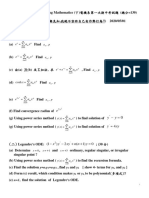Tut 4
Tut 4
Uploaded by
Max TerCopyright:
Available Formats
Tut 4
Tut 4
Uploaded by
Max TerOriginal Title
Copyright
Available Formats
Share this document
Did you find this document useful?
Is this content inappropriate?
Copyright:
Available Formats
Tut 4
Tut 4
Uploaded by
Max TerCopyright:
Available Formats
METHODS OF MATHEMATICAL PHYSICS
Dirac Delta; Green functions for ODE Tutorial Sheet 4
K: key question – explores core material
R: review question – an invitation to consolidate
C: challenge question – going beyond the basic framework of the course
S: standard question – general fitness training!
4.1 Dirac delta function [k]
1
(i) Show that δ(ax) = δ(x)
|a|
1
(ii) Show that δ(x2 − a2 ) = [δ(x + a) + δ(x − a)]
2|a|
(iii) What is xδ(x)? What is x δ 0 (x)?
Z ∞
(iv) Evaluate dx δ 0 (x2 − a2 )eiwx
−∞
(v) For a point r~0 on the unit sphere show that
1
δ(r̂ − r0 ) = δ(θ − θ0 )δ(φ − φ0 )
sin θ
where r̂ is a unit vector and θ, φ are speherical polar coordinates
4.2 Integral representation of step function [r]
Show that an integral representation of the Heaviside step function is given by
1 Z ∞−iγ eixk
θ(x) = dk
2πi −∞−iγ k
where γ > 0
4.3 Wronskian [k]
(i) Show in the case of a second order ODE
y 00 + p1 (x)y 0 + p0 (x)y = 0
that the Wronskian of two solutions Y1 (x), Y2 (x)
Y1 Y2
W (x) ≡
Y10 Y20
obeys
W 0 (x) = −p1 (x)W (x) .
(ii)* Show that the Wronskian of n solutions of an nth order ODE obeys
W 0 (x) = −pn−1 (x)W (x) .
4.4 Green Function [r]
Consider the equation for driven simple harmonic motion
y 00 (t) + w2 y(t) = f (t)
.
(i) Calculate the Wronskian using Abel’s formula. Given that one solution of the
homogeneous equation is Y1 (t) = sin wt, find a second linearly independent solu-
tion.
(ii) Using the Green Function method find a particular solution for the inhomoge-
neous equation with boundary conditions y(0) = y(π/2w) = 0.
(iii) Calculate the solution explicitly for f (t) = k sin αt.
4.5 Green function [k]
Construct the Green function for the problem
dy
y 00 (x) = f (x) for 0 < x < L ; y(0) = 0 ; =0
dx x=L
Write down the solution of the differential equation in terms of integrals over f (x), and
verify that your solution satisfies the differential equation and the boundary conditions.
4.6 Another Green function [s]
Construct the Green function for the problem
n2
( )
d dy
x − y(x) = f (x) for 0 < x < 1 ; y(0) bounded ; y(1) = 0
dx dx x
Treat the cases n = 0 and n 6= 0 separately. [ For n 6= 0, the equation is solved by x±n .]
4.7 Initial value problem [s]
Solve the initial value problem
d2 dy(t) dy(t)
2
y(t) + α = f (t) for y(0) = A =B
dt dt dt t=0
by constructing the solution in the form
Z t
y(t) = G(t, t0 )f (t0 )dt0 + ỹ(t)
0
where the first term satisfies homogeneous initial conditions.
M. R. Evans : October 30, 2005
You might also like
- Seiko Spring Drive 5R54 & 5R65 Service and Technical DatasheetDocument10 pagesSeiko Spring Drive 5R54 & 5R65 Service and Technical DatasheetJonathan van HooverplankNo ratings yet
- M2 - Mid Sem IDocument2 pagesM2 - Mid Sem IHiten AhujaNo ratings yet
- Tutorial Sheet One-1Document3 pagesTutorial Sheet One-1iddi5504No ratings yet
- MA1150AY23L3Document38 pagesMA1150AY23L3Devansh SrivastavaNo ratings yet
- First Order Differential Equations, Formulae, Solution MethodDocument2 pagesFirst Order Differential Equations, Formulae, Solution MethodKrishnan ParamasivamNo ratings yet
- Differential EquationsDocument31 pagesDifferential EquationsMansi NanavatiNo ratings yet
- Tutorial 4Document2 pagesTutorial 4ranaaditay783No ratings yet
- ODE Mathematical PhysicsDocument9 pagesODE Mathematical PhysicsHow to do anything By HimanshuNo ratings yet
- Tutorial Sheet Two-2 092724Document3 pagesTutorial Sheet Two-2 092724iddi5504No ratings yet
- MA201 Week 1 Lab NotesDocument3 pagesMA201 Week 1 Lab NotesvvvNo ratings yet
- Instructor: Dr. J. C. Kalita and Dr. Shubhamay SahaDocument3 pagesInstructor: Dr. J. C. Kalita and Dr. Shubhamay SahaMichael CorleoneNo ratings yet
- Mathematical Tripos Part IA: Complete Answers Are Preferred To FragmentsDocument9 pagesMathematical Tripos Part IA: Complete Answers Are Preferred To FragmentsKrishna OochitNo ratings yet
- Math1231 Calculus Chapter 3A: TERM II 2021Document26 pagesMath1231 Calculus Chapter 3A: TERM II 2021max zebalaNo ratings yet
- First OrderDocument113 pagesFirst Orderaadelaide083No ratings yet
- Exercise Sheet 05 2Document7 pagesExercise Sheet 05 2timoiivulaNo ratings yet
- Indian Institute of Technology Mandi, H. P. India Engineering Mathematics - IC 110 Tutorial-8 Odd Semester (2019-20)Document1 pageIndian Institute of Technology Mandi, H. P. India Engineering Mathematics - IC 110 Tutorial-8 Odd Semester (2019-20)Amit ProNo ratings yet
- Final 12Document2 pagesFinal 12Sutirtha SenguptaNo ratings yet
- Compre (2017)Document2 pagesCompre (2017)f20221235No ratings yet
- MidSem2021 - Differential EquationsDocument2 pagesMidSem2021 - Differential EquationsVivekNo ratings yet
- Imperial College London Bsc/Msci Examination June 2018 Mph2 Mathematical MethodsDocument6 pagesImperial College London Bsc/Msci Examination June 2018 Mph2 Mathematical MethodsRoy VeseyNo ratings yet
- Problem Set 2Document3 pagesProblem Set 2ananyautkarsh140904No ratings yet
- 2008 Final ExamDocument6 pages2008 Final ExamDean YuNo ratings yet
- Saadia Shahid Math-101-Fall-2021 Assignment Fundamental Theorm of Calculus Due 12/21/2020 at 08:00am ESTDocument2 pagesSaadia Shahid Math-101-Fall-2021 Assignment Fundamental Theorm of Calculus Due 12/21/2020 at 08:00am ESTAli Zain ParharNo ratings yet
- Multiple-Choice Questions, Each Problem With Single Correct AnswerDocument5 pagesMultiple-Choice Questions, Each Problem With Single Correct Answerpurplepumpkin.ee12No ratings yet
- Imperial College London Bsci/Msci Examination May 2016 Mph2 Mathematical MethodsDocument6 pagesImperial College London Bsci/Msci Examination May 2016 Mph2 Mathematical MethodsRoy VeseyNo ratings yet
- Mock Exam MM201Document4 pagesMock Exam MM201Wonji Park100% (1)
- 20085328Document7 pages20085328Lusako MwaijandeNo ratings yet
- Assignment 1 Due Date: Feb 13, 2015Document1 pageAssignment 1 Due Date: Feb 13, 2015Amrita FrancisNo ratings yet
- Ode Test Unit IIDocument4 pagesOde Test Unit IIrm4239167No ratings yet
- Assignment 5 (11-13)Document13 pagesAssignment 5 (11-13)Midhun MNo ratings yet
- Ch.2 ..... DEDocument29 pagesCh.2 ..... DEaser AldmarNo ratings yet
- ODE Cheat Sheet: Nonhomogeneous Problems Series SolutionsDocument2 pagesODE Cheat Sheet: Nonhomogeneous Problems Series SolutionsHannah Aquino NiroNo ratings yet
- Module 1 Introductory TopicsDocument30 pagesModule 1 Introductory TopicsShara ZeynNo ratings yet
- Assignment 1Document1 pageAssignment 1JOHNNo ratings yet
- MAS 201 Spring 2021 (CD) Differential Equations and ApplicationsDocument23 pagesMAS 201 Spring 2021 (CD) Differential Equations and ApplicationsBlue horseNo ratings yet
- Mathematical Methods - Assignment 3: Deadline - 5th DecemberDocument2 pagesMathematical Methods - Assignment 3: Deadline - 5th DecemberJAGANNATH RANANo ratings yet
- Differential Equations Notes: Author Vincent HuangDocument16 pagesDifferential Equations Notes: Author Vincent HuangVincent HuangNo ratings yet
- Chapter1 Chapter 2 Chapter 3 PDFDocument57 pagesChapter1 Chapter 2 Chapter 3 PDFo aburobNo ratings yet
- Sep of VarDocument4 pagesSep of VarLikhithNo ratings yet
- MATH F241 - Compre - QDocument2 pagesMATH F241 - Compre - Qharshdodal1No ratings yet
- SummaryDocument13 pagesSummaryjam.sm.7414No ratings yet
- Advanced Engineering Mathematics - Midterm1 - 1082Document4 pagesAdvanced Engineering Mathematics - Midterm1 - 1082丁乙凡No ratings yet
- AssignDocument1 pageAssignRAJESH KUMARNo ratings yet
- 337week0405 PDFDocument13 pages337week0405 PDFkjel reida jøssanNo ratings yet
- Math 276 Exam 3 AnswersDocument4 pagesMath 276 Exam 3 AnswersIroha IsshikiNo ratings yet
- C17 Worksheet Week2+Document2 pagesC17 Worksheet Week2+Hussam AgabNo ratings yet
- MATH207 - Assignment 1Document1 pageMATH207 - Assignment 1BinoNo ratings yet
- O.D.E. Assignment-03Document6 pagesO.D.E. Assignment-03AYAN DUTTANo ratings yet
- Exercises of Chapter 3Document2 pagesExercises of Chapter 3Anh Tuấn PhanNo ratings yet
- Course Summary Notes MATH2038Document7 pagesCourse Summary Notes MATH2038chunyi20198No ratings yet
- CQF Maths Primer 2023 Extra ProblemsDocument3 pagesCQF Maths Primer 2023 Extra ProblemsIse IsekemangaNo ratings yet
- Chapter 2Document6 pagesChapter 2m-6031038No ratings yet
- 2016 Endsem AnsDocument6 pages2016 Endsem AnsSingh ChitNo ratings yet
- Paperia 2 2024Document11 pagesPaperia 2 2024TNo ratings yet
- Assignment 7Document2 pagesAssignment 7vpn userNo ratings yet
- Doubleintegrals SolDocument2 pagesDoubleintegrals SolTeslim AyomideNo ratings yet
- SAPA021 - Exam 2019 1Document4 pagesSAPA021 - Exam 2019 1selomoronny29No ratings yet
- Probs 3Document3 pagesProbs 3Devang BajpaiNo ratings yet
- Feb 2005 SolutionsDocument4 pagesFeb 2005 Solutionspaul taniwanNo ratings yet
- The Calculus of Variations: August 28, 2008 21:49 World Scientific Book - 9in X 6in Brizard LagrangianDocument33 pagesThe Calculus of Variations: August 28, 2008 21:49 World Scientific Book - 9in X 6in Brizard LagrangianMartín FigueroaNo ratings yet
- Green's Function Estimates for Lattice Schrödinger Operators and ApplicationsFrom EverandGreen's Function Estimates for Lattice Schrödinger Operators and ApplicationsNo ratings yet
- Bloodstain Pattern AnalysisDocument12 pagesBloodstain Pattern AnalysisLaw RenceNo ratings yet
- Monte Carlo Algorithms With Absorbing Markov Chains: Fast Local Algorithms For Slow DynamicsDocument5 pagesMonte Carlo Algorithms With Absorbing Markov Chains: Fast Local Algorithms For Slow DynamicsWilliam Souza GarciaNo ratings yet
- Limit, Continuity and DifferentiabilityDocument23 pagesLimit, Continuity and DifferentiabilityHarsh raiNo ratings yet
- Convolution WebDocument7 pagesConvolution WebtesNo ratings yet
- JIS Steel Norms For General Structural SteelDocument3 pagesJIS Steel Norms For General Structural SteelValentin StănescuNo ratings yet
- Manual PM1111EDocument41 pagesManual PM1111ELTauszig100% (1)
- Magnetic HysteresisDocument4 pagesMagnetic HysteresisSandipan SamantaNo ratings yet
- Deep Neural Network Approximation TheoryDocument80 pagesDeep Neural Network Approximation TheorynothardNo ratings yet
- Mathematic in GeologyDocument9 pagesMathematic in GeologyR.A. Muhammed HajaniNo ratings yet
- Straight Line in 3DDocument11 pagesStraight Line in 3DNicey Raiyani100% (1)
- Advantage EP 950A ASTM E119 Wall Burn - Intertek TestDocument14 pagesAdvantage EP 950A ASTM E119 Wall Burn - Intertek TestJulio NeumannNo ratings yet
- DLL Mathematics-6 Q3 W7Document12 pagesDLL Mathematics-6 Q3 W7SHERYL SAUDANNo ratings yet
- Grose_D_1999Document80 pagesGrose_D_1999M Kevin CubasNo ratings yet
- Dempster BodySegmentParametersDocument2 pagesDempster BodySegmentParametersAlex RodriguezNo ratings yet
- Engineering Materials Exp. - 5Document10 pagesEngineering Materials Exp. - 5Nahid SultanNo ratings yet
- Norma Iso 5630-Parte1Document8 pagesNorma Iso 5630-Parte1Nestor Mejia LondoñoNo ratings yet
- 3-6. Silicon Photonic Physical Unclonable FunctionDocument12 pages3-6. Silicon Photonic Physical Unclonable Functionkamrul.malNo ratings yet
- Qw5147CASIO EF-550D-1AV EDIFICE Chronograph Series ManualDocument1 pageQw5147CASIO EF-550D-1AV EDIFICE Chronograph Series ManualSuneo DeltaNo ratings yet
- GPT - Honeywell Pressure SensorDocument10 pagesGPT - Honeywell Pressure SensorKaran Bir SinghNo ratings yet
- Abdelhaleem - 2016 - Discharge Estimation For Submerged Parallel Radial GatesDocument6 pagesAbdelhaleem - 2016 - Discharge Estimation For Submerged Parallel Radial GatesBenjamín LagosNo ratings yet
- Mathenmatics: Pearson Edexcel LUDocument22 pagesMathenmatics: Pearson Edexcel LUmuhabNo ratings yet
- Ferromagnetism Alla IsingDocument34 pagesFerromagnetism Alla IsingKoustav MukherjeeNo ratings yet
- Perturbation Theory: Giuseppe GaetaDocument601 pagesPerturbation Theory: Giuseppe Gaetaisabellazane13No ratings yet
- Measurement of Humidity: 1. Hair HygrometerDocument4 pagesMeasurement of Humidity: 1. Hair HygrometerAnusha DesaiNo ratings yet
- Condenser CalculationDocument6 pagesCondenser Calculationgreenenergykolkata100% (2)
- Andromeda Vacuum XPDocument77 pagesAndromeda Vacuum XPKaren Diffey100% (1)
- Bertat DiagramDocument2 pagesBertat Diagramsamgonz04.2002No ratings yet
- Critical Overview of Machining Simulations in ABAQUSDocument54 pagesCritical Overview of Machining Simulations in ABAQUSSharamito AkaritoNo ratings yet
- Article: Rectangular Hss Connections Close To A Chord EndDocument4 pagesArticle: Rectangular Hss Connections Close To A Chord Endclam2014No ratings yet










